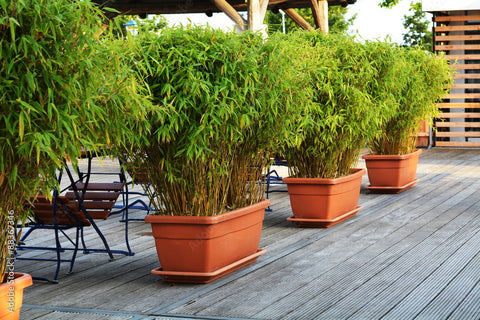Pruning bamboo: a must, when to prune and from what height? Read all about pruning bamboo here.
Apart from the fact that bamboo is very suitable for making everyday items such as toilet paper, the plant can also be used outdoors, for example for creating a bamboo screen or hedge. A bamboo plant grows quickly - like all other grass species - and maintaining the bamboo stems is therefore a must. The new shoots of the strong plant grow quickly, which means the bamboo will need to be pruned regularly. Below, we'll discuss the most important points regarding bamboo pruning.
Important question: should you prune bamboo at all?
When the bamboo plant has reached adult height after one to three years, it is beneficial to prune the bamboo from time to time. By pruning the bamboo plant, you prevent excess culms from taking up unnecessary space at the end of their life cycle. These culms typically last about ten years. Removing old stems helps stimulate new growth and create space for new culms. Pruning is usually only necessary after the bamboo has established itself. This is usually after the third to fifth growing season. The time bamboo needs to establish depends on many factors such as the planting area, species, climate zone, water, sunlight, and soil. So it is indeed beneficial to prune bamboo.

How can you prune bamboo?
First of all, keep in mind that thanks to the persistent nature of the bamboo plant, there's no reason to prune cautiously, as the bamboo culms will grow back quickly. Of course, be careful not to prune the plant so much that the bamboo gets damaged. There are four different methods to prune and trim bamboo. These are briefly highlighted below.
Maintenance pruning
The main reason to prune bamboo is to maintain the plant. With maintenance pruning, the first step is to cut off the dead bamboo culms. The dead or withered bamboo culms can be recognized by their yellow or brown color. In some cases, the culms have no leaves at all. Removing the dead culms creates space for new shoots to grow.
Part of maintenance is also thinning. Thinning means that the oldest stems that have dried out or threaten to take up too much space are cut off. In principle, any stem that takes up too much space could be cut off, but always choose the oldest and least attractive-looking bamboo stem first. In this case, it's beneficial to cut the stem as close as possible to the ground or root so that no unwanted brown stump remains visible.
Thinning bamboo
Another method to prune bamboo is by thinning the plant, for example because too many bamboo stalks are growing next to each other. This causes the air flow to decrease and less sunlight can shine through. Thinning in this case should be done when the bamboo is fully grown. The main purpose of thinning is also to maintain the beauty and elegance of the bamboo. The process of thinning the bamboo can be repeated multiple times per year. This often happens at least after winter, with stems that have suffered from winter cold. Thinning the bamboo will leave space for new and young culms with beautiful leaves.
Pruning bamboo upward
Upward pruning - pruning the bamboo plant upward - is the third method of pruning bamboo. When one wants to show the intriguing colors of bamboo culms, upward pruning is the best pruning method. During upward pruning of the bamboo plant, the lower branches of the bamboo stems are trimmed. This makes the colorful stem of the bamboo plant clearly visible. It also prevents the stem from growing back, as all shoots are removed. This maintains the bamboo plant's pruned appearance of a culm with a large bunch of leaves, similar to the appearance of a tree. Note that upward pruning does result in less privacy from the bamboo plant. A solution could be to place a low Heavenly bamboo hedge behind the pruned bamboo so that the bamboo still fully covers the wall or fence. The heavenly bamboo hedge looks different each season: it blooms, can get berries, and has deep red leaves throughout winter.
Topping bamboo
The final method to prune the bamboo plant is 'topping'. When the bamboo is topped, the upper part of the bamboo plant is pruned to the desired height. Topping is done to eliminate an uneven appearance and limit upward growth. It's also a good way to make overhanging bamboos bend less. When the top of the culm and branches are cut off, the weight of the leaves is also removed, allowing the bamboo plant to stand upright.
However, once topped, the bamboo plant will never grow vertically again and will remain at the same height throughout its life cycle. First, the desired height is determined. Particularly bamboo hedges may require a certain height and width. The stem will no longer grow, only the branches will. Then the bamboo plant is pruned with sharp pruning shears, branch cutters, or a hand saw. Always ensure that the tools used are cleaned before pruning to prevent the chance of infection. Finally, when topping bamboo, it's important that the culms are cut just above a node, approximately half a centimeter. When cutting below the node, a brown top will form.

When can I prune bamboo?
The 'best' time to prune bamboo varies by species. Generally, this is usually around the end of winter or at the end of spring. Pruning bamboo in winter ensures that the bamboo plant can grow again in spring. Moreover, bamboo stays green in winter. Towards the end of spring is good for pruning bamboo to revive the plant. At the end of winter, it's useful to clean up the plant and remove dry and damaged stems. Late spring (June-July) pruning is the most suitable time for topping and thinning.
The above-mentioned periods are the most common periods for pruning bamboo. However, fully grown culms can actually be pruned throughout the year if needed. It's only advised against pruning young shoots. These grow from mid-April to late May. Dwarf bamboo plants can be pruned at the end of winter. This gives the bamboo a more beautiful, denser, and regular shape.
From what height can I prune bamboo?
Bamboo can be pruned at any height. However, to prevent damage to new shoots emerging from the ground, it's recommended to wait with pruning until after the annual spring shooting season, when the new shoots are larger and thus more visible. In principle, bamboo can be pruned throughout the year as long as no new shoots are emerging from the ground.
Most bamboo can be pruned without damaging the plant. Discovering at what height the bamboo should be pruned is mainly a matter of taste and personal preference. Because the bamboo plant grows so quickly and can therefore be trimmed practically year-round, it doesn't matter much at what height the bamboo is pruned. So don't be afraid to use the shears well on the bamboo until it reaches the desired height.
The reason for pruning is usually to shape the plant or maintain its size. With maintenance pruning, older, dead, or unattractive culms can be sawn off at ground level. Dead branches can be sawn off at their origin. If only part of a culm or branch is removed, cut just above a node. This way, no stub remains that will die and look ugly. If the top is pruned back, it might be desirable to also shorten some side branches, so the plant looks more balanced and no long branches remain at the top. Remember to cut just above a node.
Bamboo hedges can reach a height of up to 3 meters. According to the Field Code - a Belgian code that regulates rights and obligations regarding nature management issues - a bamboo hedge between two pieces of land may be maximum 2 meters high. If the bamboo still causes nuisance, the judge can impose a lower height.

Pruning running bamboo
There are two types of bamboo: running and non-running bamboo. Running bamboo plants are more difficult to prune than non-running bamboo. Therefore, running bamboo is less advantageous to plant in the garden or on the balcony. The bamboo species grows uncontrollably, and is so strong and fast that it's difficult to keep the bamboo in check. It's therefore wise to purchase a bamboo barrier when placing running bamboo in the garden. An example of a running bamboo species is the previously mentioned Phyllostachys. Other common running bamboo species are the Pseudo Sasa and the Sasa. The Phyllostachys aurea and the Pseudosasa japonica also belong to the non-running plant species bamboo.
Running bamboo forms underground runners, also called rhizomes. The new runners don't grow very deep into the ground but spread very far horizontally. These runners create new bamboo shoots. In the case of running bamboo species, even years after the first bamboo shoot grows, a new plant can emerge from the ground meters away. This makes it more difficult to keep up with pruning.
Pruning non-running bamboo?
Unlike running bamboo, non-running bamboo species don't get runners and grow from a compact clump. A clump is a u-shaped rhizome that develops upward. These new rhizomes emerge from shoots on an existing rhizome. This stimulates the shoots to multiply within the existing surface area, causing the bamboo clumps to get a lumpy shape. An example of a non-running bamboo species is the bamboo fargesia.
Non-running bamboo plants don't 'run', making it safe to place this species in the garden or even on the balcony. However, the bamboo plants grow so quickly that they need to be pruned regularly to look their best. Take for example the Alphonse Karr bamboo. This non-running bamboo species still grows so substantially that it's desirable to prune it twice a year so it doesn't look wild and unkempt. When not pruned frequently, the culms will block views and possible exits. Click here for more information about the different types of bamboo.
In short, because bamboo grows so incredibly fast, it's desirable to prune the bamboo plant at least once a year. Bamboo can be pruned in different ways with different purposes, but the bamboo plant must be maintained one way or another. The most desired time to prune bamboo varies by species. However, this is generally around the end of winter or at the end of spring. Read more about bamboo and our Bamboi toilet paper. Or order Bamboi sustainable toilet paper right away in our webshop. Also read how to plant bamboo and care for bamboo.




































